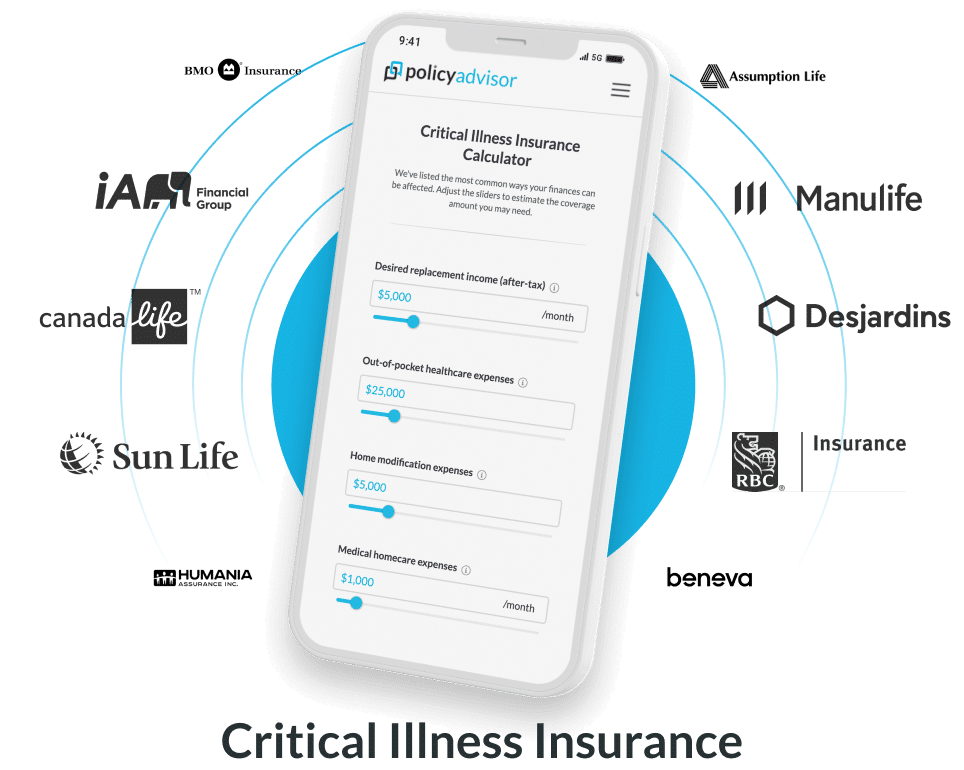- Critical illness insurance typically covers stroke as a qualifying condition, provided it meets the criteria set by the Canadian Life and Health Insurance Association (CLHIA)
- Some types of strokes may be excluded from coverage, including transient ischemic attacks (TIAs or mini-strokes), strokes caused by trauma, and lacunar strokes that don't meet the CLHIA's definition
- By offering a tax-free lump-sum payment, critical illness insurance can help you manage the financial and medical impact of stroke and other life-threatening conditions
Every year over 100,000 Canadians will experience a stroke, making it the leading cause of adult disability in the country (source: the Heart and Stroke Foundation of Canada). Symptoms vary, but the short and long-term effects of a stroke can be debilitating and even life-threatening. Strokes are also the third leading cause of death in Canada.
While insurance can’t protect against the medical risk of stroke, it can provide a financial safety net should you or a loved one be diagnosed with this critical illness. Critical illness insurance can help pay for treatment, care, or general support. In Canada, strokes represent the third most common diagnosis claimed through critical illness insurance.
Keep reading to find out more about how critical illness insurance can benefit you if you or a loved one is at risk for stroke.
What is critical illness insurance?
Critical illness insurance provides a tax-free lump sum payment if you’re diagnosed with a life-threatening illness or experience a serious health event covered by your insurer. While available as a standalone policy, you can also add it to your life insurance plan as a rider (or an optional add-on), though its coverage may be limited.
Unlike regular health insurance that covers ongoing medical expenses, critical illness insurance offers a one-time payment that you can use however you need, whether that’s for replacing lost income, supporting your family, or paying off debts.
What is a stroke?
A stroke, or cerebrovascular accident, occurs when the brain loses blood flow due to a hemorrhage, embolism, or thrombosis. This loss of blood damages brain cells, leading to stroke symptoms. Early warning signs include numbness, confusion, severe headaches, and loss of balance, while long-term effects can include speech impairments, memory problems, and permanent loss of function.
There are three main types of stroke:
- Ischemic strokes: The most common type of strokes, ischemic strokes are caused when a blood vessel in the brain becomes blocked by a blood clot or plaque buildup
- Hemorrhagic stroke: Occurs when a blood vessel in the brain ruptures. This type is often linked to high blood pressure and can cause severe damage as blood pools in the brain
- Transient ischemic attack (TIA): Often called a “mini-stroke,” a TIA occurs when blood flow to the brain is temporarily blocked. While symptoms are usually mild and short-lived, a TIA often serves as a warning sign that a more severe stroke may be imminent
Does Critical illness insurance cover stroke?
Yes! Strokes fall under covered health conditions in most critical illness insurance policies. In fact, strokes are one of the main conditions covered by both basic critical illness policies (covering 3 or 4 conditions) and enhanced critical illness insurance policies (covering 25 or 26 conditions).
Coverage conditions
Most Canadian insurers use (and adhere to) the Canadian Life and Health Insurance Association’s (CLHIA) definition of stroke when assessing claims for the condition. According to the CLHIA, a stroke is an acute cerebrovascular event caused by intracranial thrombosis, or hemorrhage, or embolism from an extracranial source, with:
- Acute onset of new neurological symptoms, and
- New objective neurological deficits on clinical examination,
- Persisting for more than 30 days following the date of diagnosis. These new symptoms and deficits must be corroborated by diagnostic imaging testing. The diagnosis of stroke must be made by a specialist
Potential Exclusions
Depending on the type or severity of stroke, there may be exclusions. For example, TIAs or mini-strokes, intracerebral vascular events (strokes caused by trauma), and lacunar strokes that don’t meet the above definition may not be covered.
How long do I have to wait to file a claim after having a stroke?
Most critical illness insurance policies include a survival period clause. This means you must survive for at least 30 days after a stroke diagnosis before filing a claim. It is only after this period that the benefit will be paid.
Most companies will require medical information about the diagnosis, including signs, symptoms, and related investigations, within six months of the date of diagnosis.
Can I get critical illness insurance after having a stroke?
Yes, you can buy critical illness insurance after having a stroke in Canada. You have two options:
- Guaranteed critical illness insurance: This coverage doesn’t require a medical evaluation but includes a two-year pre-existing condition exclusion. This means if you had a stroke within two years before applying, the policy won’t pay out if another stroke occurs during the first two years of coverage. The exclusion may also apply to other critical illnesses directly related to the stroke
- Traditional fully underwritten insurance: Depending on the severity of your stroke and how much time has passed (typically several years), you may qualify for traditional, fully underwritten insurance. Your eligibility will be assessed based on your medical history and current health status
Can I get critical illness insurance if I have a family history of stroke?
Yes, but your eligibility and premiums will be based on your current health condition and risk factors. If you have a family history of stroke, insurers will take that into account while deciding on your premiums and coverage levels. You may receive an insurance rating, leading to higher premiums, or specific coverage exclusions.
Despite this, if you’re at high risk for stroke due to family history, you should absolutely get critical illness insurance. We recommend speaking with an insurance advisor to understand how your family history might affect your coverage options.
How can I purchase critical illness insurance?
You can buy critical illness insurance as an individual policy, get coverage through your employer, or opt for a special plan that’s linked to your mortgage:
- Individual policy: You can purchase this directly through an insurance agent or online. These types of policies usually require medical underwriting but also give you more control over your coverage
- Group plan: You might already have access to this through your employer or a professional association. These plans are partially or fully paid for by their providers, and their coverage usually ends when you’re no longer associated with them
- Special-purpose plan: This type of insurance covers your loan payments for a set period if you’re diagnosed with a covered condition. You can apply for it when completing your loan application or after your loan’s approval
You can hold multiple types of critical illness insurance simultaneously for broader protection. As always, we recommend booking a free consultation with our licensed advisors for personalized guidance on your coverage needs.
Frequently Asked Questions
Is stroke covered by critical illness insurance?
Yes, most critical illness insurance policies cover stroke as a qualifying condition, provided it meets the CLHIA’s definition of stroke (see above) and doesn’t fall under any exclusions. Many insurance companies, including Sun Life, don’t cover mini-strokes (TIAs), strokes caused by trauma, or lacunar strokes that don’t meet the CLHIA’s definition.
What are the benefits of having critical illness insurance in case of a stroke?
Critical illness insurance provides a tax-free lump-sum payment upon the diagnosis of a stroke that you can use for:
- Medical and recovery costs: Pay for specialized treatments and rehabilitation services, or hire private healthcare support
- Income replacement: Cover your living expenses while you’re unable to work
- Home modifications: Adapt your living space to accommodate any physical limitations
- Debt management: Keep up with mortgage payments and other financial obligations
- Family support: Help your family maintain their standard of living or cover caregiving costs
Critical illness insurance policies provide a tax-free lump-sum payment if you’re diagnosed with one of the covered conditions. While strokes are typically covered under critical illness insurance, certain types may be excluded, depending on their severity and policy terms. Common exclusions include transient ischemic attacks (TIAs or mini-strokes), strokes caused by trauma, and lacunar strokes that do not meet the CLHIA’s criteria.




